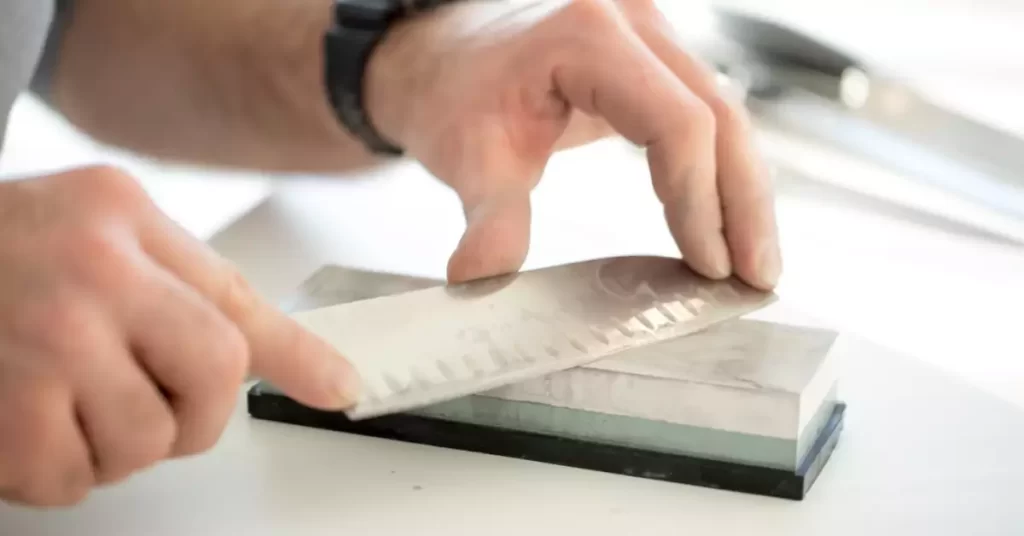Arkansas stones and Japanese waterstones both possess unique characteristics that make them popular choices for sharpening tools and knives. But when it comes to deciding which one is superior, the answer may not be as straightforward as you’d expect.
In this in-depth comparison, we’ll explore the differences between Arkansas stones and Japanese waterstones, evaluate their respective advantages and disadvantages, and help you make an informed decision on which one is right for you.
What are Arkansas Stones?
Origins and Composition
Arkansas stones are natural sharpening stones that originate in the Ouachita Mountains of Arkansas, USA. They are composed mainly of novaculite, a type of microcrystalline quartz that gives the stones their characteristic hardness and fine grit.
Types of Arkansas Stones
Arkansas stones come in different grades, which are primarily determined by their density and color:
Soft Arkansas: This stone has a coarse texture and is ideal for initial sharpening or removing small chips from a blade.
Hard Arkansas: This medium-fine grit stone is suitable for refining the edge of a knife or tool after using a soft stone.
Black Arkansas: As the finest grit Arkansas stone, it provides an ultra-fine edge for razor-sharp results.
Translucent Arkansas: Similar to the black Arkansas stone, this stone is prized for its translucency and ultra-fine grit.
What are Japanese Waterstones?
Origins and Composition
Japanese waterstones, also known as whetstones, are synthetic sharpening stones made from a combination of abrasive grit and a binding agent. They are designed to be soaked in water before use, which helps to create a slurry that aids in sharpening.
Types of Japanese Waterstones
Japanese waterstones come in various grits, ranging from very coarse (around 220 grit) to ultra-fine (up to 10,000 grit). The most common types include:
- Coarse stones: For initial sharpening or removing chips from a blade.
- Medium stones: For refining the edge after using a coarse stone.
- Fine stones: For polishing the edge and achieving a razor-sharp finish.

Comparing Arkansas Stones and Japanese Waterstones
Sharpening Speed
Japanese waterstones typically sharpen faster than Arkansas stones due to their softer and more friable nature, which allows for a more aggressive cutting action. Arkansas stones, on the other hand, are slower cutting but can provide a more consistent and controlled sharpening process.
Grit Range
Japanese waterstones offer a wider range of grits, making them more versatile for different sharpening needs. Arkansas stones, while available in various grades, do not provide as wide a grit range as their Japanese counterparts.
Maintenance
Arkansas stones require minimal maintenance, as they do not need to be soaked in water before use and can be cleaned easily with water and a soft brush. Japanese waterstones, on the other hand, need to be soaked before use and may require flattening over time due to wear.
Durability
Arkansas stones are generally more durable than Japanese waterstones due to their harder and less friable composition. This means they can last longer and maintain their shape better than their Japanese counterparts.
FAQs
Can I use oil on a Japanese waterstone?
No, Japanese waterstones are designed to be used with water, not oil. Using oil on a Japanese waterstone can damage the stone and reduce its effectiveness.
Can I use water on an Arkansas stone?
Yes, you can use water on an Arkansas stone, although oil is more commonly used. Using water will result in a different sharpening experience and may require more frequent cleaning of the stone during the sharpening process.
How do I choose the right grit for my sharpening needs?
The appropriate grit depends on the condition of your blade and your desired level of sharpness. For repairing a damaged edge or initial sharpening, a coarse grit (220-600) is recommended.
For refining an edge, a medium grit (700-2000) is suitable. Finally, for polishing and achieving a razor-sharp edge, a fine grit (3000-10,000) is ideal.
Final Verdict: Which is Better?
Ultimately, the choice between Arkansas stones and Japanese waterstones comes down to personal preference and specific sharpening needs.
Arkansas stones provide a more controlled and consistent sharpening experience, with minimal maintenance and greater durability. They may be better suited for those who value a traditional approach to sharpening and require less frequent use.
On the other hand, Japanese waterstones offer a wider range of grits and faster sharpening action. They are well-suited for those who need versatility in their sharpening tools or want to achieve a razor-sharp edge more quickly. However, they do require more maintenance and may have a shorter lifespan compared to Arkansas stones.
